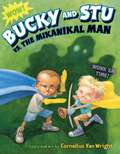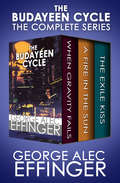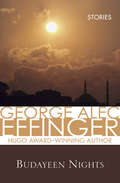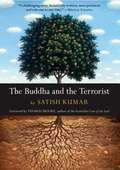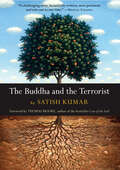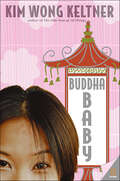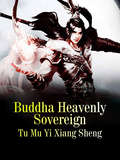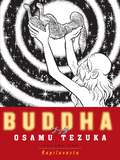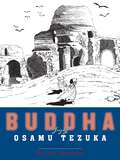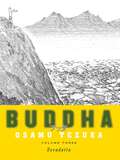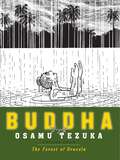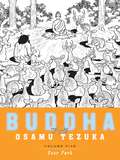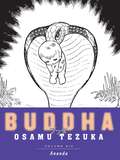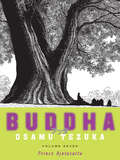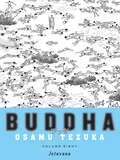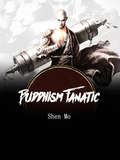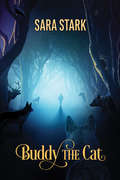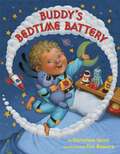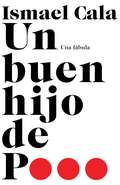- Table View
- List View
Bucky and Stu vs. the Mikanikal Man
by Cornelius Van WrightIt’s the adventure of a lifetime when best friends—and self-proclaimed superheroes—defeat bad guys of their own invention. It’s wonk ’em time when Bucky and Stu have to stand up to Phat Tyre, TrashMan and Hose-Nose. No matter that the bad guys are all made out of household items that Bucky and Stu have assembled themselves—these bad guys don’t stand a chance against the boys’ power moves. Still, it’s quite a surprise when their latest villain, the giant Mikanikal Man, gets zapped during a lightning storm and comes to life! The battle—and thrill—of a lifetime ensue. Full of surprises and laughs, this upbeat, action-packed story celebrates imagination, creativity, and friendship in even the most unexpected forms. Cornelius Van Wright’s hilarious illustrations are full of surprises and are perfect for portraying the high-speed antics of two enthusiastic boys.
El Buda y el microbús
by Apo HalmyrisUn libro sapiencial contemporáneo. El camino a la iluminacón puede dar unos giros aparentemente sorpresivos.
The Budayeen Cycle: When Gravity Fails, A Fire in the Sun, and The Exile Kiss (The Budayeen Cycle #3)
by George Alec EffingerThe complete Hugo and Nebula Award–nominated cyberpunk trilogy by an author whose work is “wry and black and savage” (George R. R. Martin). Praised as “a perfect example of how exciting the subgenre can and should be,” George Alec Effinger’s Budayeen Cycle is a towering and timeless science fiction achievement that continues to amaze, shock, and captivate readers (SF Signal). When Gravity Fails: Set in a high-tech near future featuring an ascendant Muslim world and divided Western superpowers, this cult classic takes readers into a world with mind- or mood-altering drugs for any purpose, brains enhanced by electronic hardware, and surgically altered bodies. Street hustler Marîd Audran has always prided himself on his independence, free from commitments, connections, and even cybernetic modifications. But when a string of brutal murders lands him on the radar of Friedlander Bey, the most powerful and dangerous man in the decadent Arab ghetto, the Budayeen, Audran is forced to change his loner ways, or risk losing his life . . . A Fire in the Sun: Once a small-time smuggler, Marîd Audran has, to his chagrin, moved up in the ranks of the criminal underworld to become a lieutenant in Friedlander Bey’s shadowy empire. Tasked with being Bey’s eyes and ears inside local law enforcement, Audran finds himself tracking yet another serial killer through the streets of the Budayeen. And the closer he gets to his target, the more embroiled he becomes in the deadly political machinations hidden behind the city’s façade. The Exile Kiss: Marîd Audran is finally learning to appreciate the wealth and benefits that come from being on Friedlander Bey’s payroll when a powerful enemy does the unthinkable, and gets both Audran and Bey exiled from the Budayeen. Abandoned in the lifeless and lethal Arabian Desert, Audran and Bey have only one option: survive long enough to exact revenge on the man responsible.
Budayeen Nights: Stories
by George Alec EffingerA &“brilliant collection&” of short stories set in a &“marvelously realized, imaginary Muslim city&” from the Hugo and Nebula Award–winning author (Publishers Weekly, starred review). Long identified as a science fiction writer, except in his own eyes, George Alec Effinger had some of his biggest critical and commercial success with a series even he recognized and characterized as SF. Set in the marvelously realized, imaginary Muslim city of Budayeen, the three novels, When Gravity Fails, A Fire in the Sun and The Exile Kiss garnered rave reviews, award nominations and a wide readership. In addition, Effinger came to be recognized as one of the foundational writers of cyberpunk. Although the novels are perhaps how Budayeen and their hero, Marid Audran, are best known, there are a handful of shorter pieces that add to the vividly drawn and deeply authentic picture of an imagined world and seven short stories, the first part of an uncompleted novel and a story fragment add to the mental images of this exotic and yet somehow completely familiar city and world that Effinger created. This book was originally published by Golden Gryphon Press and comes with a Forword and story notes by Effinger's widow, Barbara Hambly. The lead story in this collection, "Schrodinger's Kitten," won the Hugo, Nebula and Seiun Awards.
The Buddha and the Terrorist
by Satish Kumar Thomas Moore Allan Hunt BadinerInternational terrorism may have become the central specter of our time, but the threat of violence is as old as history. Among all the experiences of the Buddha, perhaps this story of his eye-to-eye encounter with a fearsome terrorist is the one most relevant and vital for us today. What happens when a man committed to violence is confronted by a man committed to nonviolence? Who is more powerful? Who can influence whom? The Buddha, Jesus Christ, Mahatma Gandhi, Martin Luther King Jr., the Dalai Lama, have all sought to inspire us. Satish Kumar's retelling of the ancient Buddhist tale of transformation speaks to the possibility of changing the world. This small book contains an unassailable spiritual and practical message and inspired guidance in the use of nonviolent resistance in the quest for lasting peace. The Buddha's approach is one of engagement and dialogue--even toward those with whom he disagrees. No one can read this tale without thinking about the root causes of terrorism, about good and evil, about justice and forgiveness, about the kind of place we want the world to be, and about the most productive and practical way to get there.
The Buddha and the Terrorist: The Story Of Angulimala
by Thomas Moore Satish KumarA Buddhist parable on confronting violence offers “a profound message about hope in the midst of seemingly hopeless terrors” (Robert Thurman). In this timely retelling of an ancient Buddhist parable, peace activist Satish Kumar has created a small book with a powerful spiritual message about ending violence. It is a tale of a fearsome outcast named Angulimala (“Necklace of Fingers”), who is terrorizing towns and villages in order to gain control of the state, and murdering people and adding their fingers to his gruesome necklace. One day he comes face to face with the Buddha and is persuaded, through a series of compelling conversations, to renounce violence and take responsibility for his actions. The Buddha and the Terrorist addresses the urgent questions we face today: Should we talk to terrorists? Can we reason with religious fundamentalists? Is nonviolence practical? The story ends with a dramatic trial that speaks to the victims of terrorism—the families whose mothers, fathers, sons, and daughters Angulimala has murdered. It asks whether it is possible for them to forgive. Or whether it is even desirable. No one can read The Buddha and the Terrorist without thinking about the root causes of terrorism, about good and evil, about justice and forgiveness, about the kind of place we want the world to be, and, most importantly, about the most productive and practical way to get there. The wisdom within this book provides “a crucial alternative to the unending cycle of bloodshed and retaliation” (Booklist). “This kind of parable has a calming effect on the mind. The change in outlook from anger to compassion is also contagious, also powerful.” —Los Angeles Times Book Review “A challenging story, beautifully written, most pertinent and relevant to our time.” —Deepak Chopra
Buddha Baby
by Kim Wong KeltnerWant to learn a thing or two about a young Chinese-Americanwoman with a penchant for Hello Kitty toys, who could be found squeezing into jeans at Old Navy while being asked for detailed explanations of Yo-Yo Ma's success?Then get ready for:WHOLindsey Owyang, raised on Spaghetti-O'sand Aaron Spelling productionsWHATHer Secret Asian Man finally proposes!WHERESpringtime in San Francisco and it's raining stone cold foxesHOWLindsey wants to make her peace with Chinatown & country,but will a crotchety Chinese grandmother stand in her way?WHYBecause she never expected her hottie crush fromsixth grade to show up now ...As Lindsey continues her quest for identity, family secrets, and true love, will she find double happiness, or will she be tempted by one last lion dance with a stranger? Ultimately, Lindsey realizes that Chinese girls really wanna have chow fun.
Buddha Heavenly Sovereign: Volume 1 (Volume 1 #1)
by Tu MuyixiangshengIn his previous life he had fused his Primordial Spirit and mastered the Grand Dao of Immortality Whoever wanted to block his way would have no mercy
Buddha Heavenly Sovereign: Volume 2 (Volume 2 #2)
by Tu MuyixiangshengIn his previous life he had fused his Primordial Spirit and mastered the Grand Dao of Immortality Whoever wanted to block his way would have no mercy
Buddha, Volume 1: Kapilavastu (Buddha #1)
by Osamu TezukaOsamu Tezuka's vaunted storytelling genius, consummate skill at visual expression, and warm humanity blossom fully in his eight-volume epic of Siddhartha's life and times. Tezuka evidences his profound grasp of the subject by contextualizing the Buddha's ideas; the emphasis is on movement, action, emotion, and conflict as the prince Siddhartha runs away from home, travels across India, and questions Hindu practices such as ascetic self-mutilation and caste oppression. Rather than recommend resignation and impassivity, Tezuka's Buddha predicates enlightenment upon recognizing the interconnectedness of life, having compassion for the suffering, and ordering one's life sensibly. Philosophical segments are threaded into interpersonal situations with ground-breaking visual dynamism by an artist who makes sure never to lose his readers' attention. Tezuka himself was a humanist rather than a Buddhist, and his magnum opus is not an attempt at propaganda. Hermann Hesse's novel or Bertolucci's film is comparable in this regard; in fact, Tezuka's approach is slightly irreverent in that it incorporates something that Western commentators often eschew, namely, humor.
Buddha, Volume 2: The Four Encounters (Buddha #2)
by Osamu TezukaOsamu Tezuka's vaunted storytelling genius, consummate skill at visual expression, and warm humanity blossom fully in his eight-volume epic of Siddhartha's life and times. Tezuka evidences his profound grasp of the subject by contextualizing the Buddha's ideas; the emphasis is on movement, action, emotion, and conflict as the prince Siddhartha runs away from home, travels across India, and questions Hindu practices such as ascetic self-mutilation and caste oppression. Rather than recommend resignation and impassivity, Tezuka's Buddha predicates enlightenment upon recognizing the interconnectedness of life, having compassion for the suffering, and ordering one's life sensibly. Philosophical segments are threaded into interpersonal situations with ground-breaking visual dynamism by an artist who makes sure never to lose his readers' attention. Tezuka himself was a humanist rather than a Buddhist, and his magnum opus is not an attempt at propaganda. Hermann Hesse's novel or Bertolucci's film is comparable in this regard; in fact, Tezuka's approach is slightly irreverent in that it incorporates something that Western commentators often eschew, namely, humor.
Buddha: Volume 3: Devadatta (Buddha #3)
by Osamu TezukaThe Eisner and Harvey Winner The third volume of this epic graphic novel send Siddhartha further into a world mired in pain and suffering. The journey to peace and enlightenment looms far but bright. Prince Siddhartha quickly learns that the monk's path is covered in thorns and self-abuses much more profound than shaving your head. His new companions Dhepa and Assaji accompany him to plague-ridden town, ruled by the ravishing Visakha. On a different path filled with as many vagaries is Devadatta, an orphan who learns only that bad almost always gets worse. To strange cities, and dire prophecies...
Buddha: Volume 4: The Forest of Uruvela (Buddha #4)
by Osamu TezukaThe Eisner and Harvey Winner In this fourth volume of the award-winning graphic novel biography, Buddha slowly discovers that his destiny lies in a path not readily available to him. With fellow ascetics Dhepa who has complete faith in the purifying quality of painful physical ordeals, and Assaji, who can predict everyone's death to the hour, Buddha travels through the kingdom of Magadha into the Forest of Uruvela, where The Middle Path and Enlightenment wait beyond a series of death-defying trials. Awake under the Pippala tree...
Buddha: Volume 5: Deer Park (Buddha #5)
by Osamu TezukaIn the fifth installment of manga-godfather Osamu Tezuka's Buddha, engagement with death imparts the lesson of life's sanctity. In a Machiavellian rise to power, Devadatta, a rogue aristocrat, incites war between two kingdoms that will leave thousands dead. King Bimisara of Magadha, fearing death his son's own hand, withdraws fatherly love. The true measure of the Buddha's divinity will turn out to be a test of diplomacy - the power of words.
Buddha: Volume 6: Ananda (Buddha #6)
by Osamu TezukaIn the sixth volume of manga visionary Osamu Tezuka's Buddha, the devil Mara possesses the bandit Ananda, half-brother of Devadatta, in an effort to eliminate the Buddha. A ruthless killer who is impervious to physical harm, Ananda will retain the devil's favor only if he spurns his love interest. When Ananda and his bandit buddy attack the Fire Shrine of the Brahmin brothers Kassapa, it is none other than the Awakened One who happens by. Buddha must confront his eternal enemy, Mara, before he can open the eyes of arrogant priests and hardened criminals.
Buddha: Volume 7: Prince Ajatasattu (Buddha #7)
by Osamu TezukaOsamu Tezuka's vaunted storytelling genius, consummate skill at visual expression, and warm humanity blossom fully in his eight-volume epic of Siddhartha's life and times. Tezuka evidences his profound grasp of the subject by contextualizing the Buddha's ideas; the emphasis is on movement, action, emotion, and conflict as the prince Siddhartha runs away from home, travels across India, and questions Hindu practices such as ascetic self-mutilation and caste oppression. Rather than recommend resignation and impassivity, Tezuka's Buddha predicates enlightenment upon recognizing the interconnectedness of life, having compassion for the suffering, and ordering one's life sensibly. Philosophical segments are threaded into interpersonal situations with ground-breaking visual dynamism by an artist who makes sure never to lose his readers' attention. Tezuka himself was a humanist rather than a Buddhist, and his magnum opus is not an attempt at propaganda. Hermann Hesse's novel or Bertolucci's film is comparable in this regard; in fact, Tezuka's approach is slightly irreverent in that it incorporates something that Western commentators often eschew, namely, humor.
Buddha: Volume 8: Jetavana (Buddha #8)
by Osamu TezukaOsamu Tezuka's vaunted storytelling genius, consummate skill at visual expression, and warm humanity blossom fully in his eight-volume epic of Siddhartha's life and times. Tezuka evidences his profound grasp of the subject by contextualizing the Buddha's ideas; the emphasis is on movement, action, emotion, and conflict as the prince Siddhartha runs away from home, travels across India, and questions Hindu practices such as ascetic self-mutilation and caste oppression. Rather than recommend resignation and impassivity, Tezuka's Buddha predicates enlightenment upon recognizing the interconnectedness of life, having compassion for the suffering, and ordering one's life sensibly. Philosophical segments are threaded into interpersonal situations with ground-breaking visual dynamism by an artist who makes sure never to lose his readers' attention. Tezuka himself was a humanist rather than a Buddhist, and his magnum opus is not an attempt at propaganda. Hermann Hesse's novel or Bertolucci's film is comparable in this regard; in fact, Tezuka's approach is slightly irreverent in that it incorporates something that Western commentators often eschew, namely, humor.
Buddhism Fanatic: Volume 5 (Volume 5 #5)
by Shen MoThe Ancestral Buddha prophesied: Eighty-four thousand years later, when the Buddhist Mantra dissipated and the Taoism was cut off, the Buddhist disciple Lu Yang was reborn with the "Devil Subduing Heaven Book". With his Diamond Body, he started cultivating his demonic powers internally, and from then on, he embarked on a path of cultivation that defied the heavens. He pointed to the sky with his left hand and the earth with his right — he was the supreme being in all the heavens and the earth!
Buddhism Fanatic: Volume 6 (Volume 6 #6)
by Shen MoThe Ancestral Buddha prophesied: Eighty-four thousand years later, when the Buddhist Mantra dissipated and the Taoism was cut off, the Buddhist disciple Lu Yang was reborn with the "Devil Subduing Heaven Book". With his Diamond Body, he started cultivating his demonic powers internally, and from then on, he embarked on a path of cultivation that defied the heavens. He pointed to the sky with his left hand and the earth with his right — he was the supreme being in all the heavens and the earth!
Buddhism Fanatic: Volume 7 (Volume 7 #7)
by Shen MoThe Ancestral Buddha prophesied: Eighty-four thousand years later, when the Buddhist Mantra dissipated and the Taoism was cut off, the Buddhist disciple Lu Yang was reborn with the "Devil Subduing Heaven Book". With his Diamond Body, he started cultivating his demonic powers internally, and from then on, he embarked on a path of cultivation that defied the heavens. He pointed to the sky with his left hand and the earth with his right — he was the supreme being in all the heavens and the earth!
Buddhism Fanatic: Volume 8 (Volume 8 #8)
by Shen MoThe Ancestral Buddha prophesied: Eighty-four thousand years later, when the Buddhist Mantra dissipated and the Taoism was cut off, the Buddhist disciple Lu Yang was reborn with the "Devil Subduing Heaven Book". With his Diamond Body, he started cultivating his demonic powers internally, and from then on, he embarked on a path of cultivation that defied the heavens. He pointed to the sky with his left hand and the earth with his right — he was the supreme being in all the heavens and the earth!
Buddhism Fanatic: Volume 4 (Volume 4 #4)
by Shen MoThe Ancestral Buddha prophesied: Eighty-four thousand years later, when the Buddhist Mantra dissipated and the Taoism was cut off, the Buddhist disciple Lu Yang was reborn with the "Devil Subduing Heaven Book". With his Diamond Body, he started cultivating his demonic powers internally, and from then on, he embarked on a path of cultivation that defied the heavens. He pointed to the sky with his left hand and the earth with his right — he was the supreme being in all the heavens and the earth!
Buddy the Cat
by Sara StarkNoel is a lonely librarian who spends most of his time working, surfing dating websites to no avail, and hanging out with the cat who shows up on his balcony every night. When he meets Mike, he's finally found a man who holds his interest. But it soon becomes clear that there's more to the bird-chasing businessman than what's on the surface.A story from the Dreamspinner Press 2016 Daily Dose package "A Walk on the Wild Side".
Buddy's Bedtime Battery (Growing with Buddy #1)
by Christina GeistIt&’s Buddy&’s bedtime, but there&’s just one problem—he&’s decided that he&’s a robot! His accommodating parents must now &“power down&” their little machine step by step, from his toes to his tushy. Tim Bowers&’s bubbly illustrations capture Buddy&’s energy and imagination, and parents and kids will enjoy adopting this new bedtime ritual into their own routines.
Un buen hijo de p...
by Ismael CalaSegundo libro de la serie Cala Contigo Rompe paradigmas para transformar tu vida¿Hijo de p...? No, no es lo que piensas. Las pes de las que hablamos aquí son otras muy diferentes. Tras el enorme éxito de su primer libro El poder de escuchar, el presentador de CNN en Español y conferencista en desarrollo humano Ismael Cala vuelve con una fábula inspiradora sobre el desarrollo humano, los significados reales de nuestras historias de vida, la inteligencia emocional, la búsqueda del éxito y el bienestar interior que nos ayudará a transformar la manera en que vivimos nuestras vidas. A través de la historia y las conversaciones de dos personajes, Arturo y Chris, Cala nos enseña como sólo nosotros mismos tenemos el poder de transformar nuestras vidas y que con el poder de la mente y el amor, todo es posible. Esta forma de vivir queda encapsulada en las tres pes: la pasión, la paciencia y la perseverancia, que nos permitirán no sólo llegar a nuestra cima, sino aprovecharla y disfrutarla. ¿Estás dispuesto a convertirte en buen hijo de p...?
